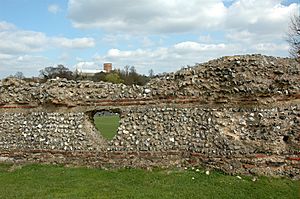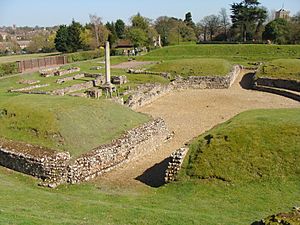Verulamium facts for kids
Verulamium was an ancient town in Roman Britain. It was located in the southwest of the modern city of St Albans in Hertfordshire, England.
Much of this Roman city is still buried underground. The modern city of St Albans was built on top of it. An important Roman road called Watling Street passed right through Verulamium. This made it one of the most important towns in Roman Britain. Today, much of the site is a protected ancient monument.
Contents
Before the Romans Arrived
Before the Romans came, a tribe called the Catuvellauni lived here. They called their settlement Verlamion. This was one of the very first places in Britain to be recorded by name.
A Town Rebuilt
In AD 61, a famous queen named Boudica led a rebellion. Her tribe, the Iceni, attacked Verulamium. The town was burned to the ground, and many people were killed. Scientists have found a layer of black ash. This ash confirms the Roman stories about the fire.
After this destruction, the town was rebuilt. It grew quite large, covering about 125 acres (0.5 square kilometers) by the early 3rd century. A deep ditch and a strong wall protected the town.
Saint Alban's Story
Verulamium is also famous for St Alban. He was a Roman noble who became a Christian. He was killed for his faith here, becoming the first Christian martyr in Britain. A martyr is someone who dies for their beliefs.
Important Buildings
Verulamium had many important Roman buildings. These included a Roman Forum (a public square), a basilica (a large public hall), and a Roman theatre.
The town suffered from fires again in AD 155 and AD 250. After these fires, the town was rebuilt using stone instead of wood. This happened at least twice over the next 150 years. The Romans stopped living in Verulamium between 400 and 450 AD.
What You Can See Today
Today, you can still see some parts of the Roman city. There are parts of the old city walls. You can also see a hypocaust (an ancient heating system) still under a mosaic floor. The remains of the theatre are on land owned by the Earl of Verulam. Many more ancient remains are still buried under nearby farmland. They have never been dug up by archaeologists.
Images for kids
See also
 In Spanish: Verulamium para niños
In Spanish: Verulamium para niños





